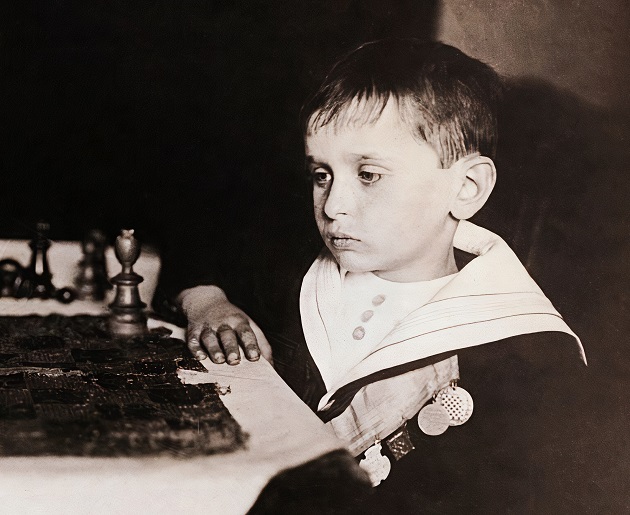
Edward Winter

Samuel Reshevsky (Bettmann Archive – reproduced with permission)
C.N. 1518 (see pages 61-66 of Chess Explorations) commented that ‘chess writers wishing to illustrate the play of the chess prodigy Samuel Reshevsky tend to make their selection from among the same small number of games’, and after listing 12 that fell into that category we gave roughly the same number of forgotten games played in 1920-22. Page 28 of Kings, Commoners and Knaves showed the conclusion of a 1921 game won by Reshevsky against C.W. De Graff, an item that we originally gave in Kingpin in 1995. These efforts preceded the appearance of Samuel Reshevsky A Compendium of 1768 Games with Diagrams, Crosstables, Some Annotations, and Indexes by Stephen W. Gordon (Jefferson 1997).
An endnote on page 258 of Chess Explorations:
C.N. 1631 quoted a fanciful passage about Reshevsky, supplied by Robert Sinnott (Norwell, MA, USA), in the Boston Post of 4 April 1921 (page 2):
‘... He follows the moves [of the Lasker v Capablanca title match] as reported closely, commenting upon them, and solving their intricacies.
Many people have asked why the boy does not play the champions for world’s honors. Those who have charge of the lad are opposed to a match with the champions, but not on the ground that Samuel could not defeat his famed opponents. Such a match would be of a [sic] days and weeks, probably inasmuch as the champions move with great care and devote much time to planning moves. The mental strain on the young mind might have an injurious effect on his intellect and health, and for that reason, any talk of a championship contest has been tabooed.’
The ‘complete games’ collection by Stephen W. Gordon unfortunately overlooks four scores given on pages 122-127 of the June 1920 La Stratégie. Of these the liveliest is given below, and it is quite a game. Played in a 20-board simultaneous exhibition (+18 –1 =1), it shows the prodigy fighting back strongly after throwing away his queen to an elementary knight fork:
S. Reshevsky – L. Schwarz
Paris, 8 June 1920
French Defence
1 e4 e6 2 d4 c6 3 Nf3 d5 4 e5 h6 5 Bd3 Bb4+ 6 c3 Ba5 7 O-O Ne7 8 Re1 Nd7 9 Nbd2 Nf8 10 Nf1 Nfg6 11 Ng3 O-O 12 Nh5 Kh7 13 Qd2 Ng8 14 g3 Bd7 15 Nh4 Be8 16 f4 Kh8 17 Ng2 Qe7 18 g4 Nh4 19 f5 Nf3+ 20 Kh1 Nxd2 21 Bxd2 exf5 22 gxf5 Qd7 23 Nhf4 Bd8 24 h4 Ne7 25 Ne3 f6 26 e6 Qd6 27 Neg2 Bc7 28 Be3 g5 29 fxg6 Rg8 30 h5 Kg7 31 Nh4 b6 32 Rad1 c5 33 Bb1 Bc6 34 Kg1 Rae8 35 Bc2 Qd8 36 b4 cxd4 37 cxd4 Rgf8 38 Bf5 Qb8 39 Rf1 Rd8 40 Rf2 Bb5 41 Re1 Bd6 42 a3 Rc8 43 Kh1 Rc3 44 Bd2 Rxa3 45 Rg1 Ra2 46 Nfg2 Bc4 47 Bb1 Ra1 48 Ne3 f5 49 Nexf5+ Nxf5 50 Nxf5+ Rxf5 51 Rxf5 Ra3 52 Rf7+ Kg8 53 Bf5 Bf4 54 g7 Bg5 55 Bxg5 hxg5 56 Rf8+ Qxf8 57 gxf8(Q)+ Kxf8 58 h6 g4 59 Bxg4 Bd3 60 Rf1+ Kg8 61 e7 Be4+ 62 Kh2 Ra2+ 63 Kh3 Bg6 64 Be6+ Kh7 65 Rf7+ Resigns.
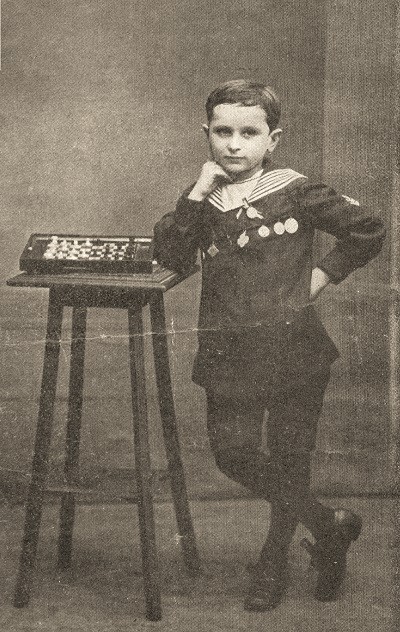
La Stratégie, June 1920
(2472)
We reproduced the Reshevsky v Schwarz game on page 98 of A Chess Omnibus.
Now an eye-witness report of Reshevsky’s simultaneous display at Swiss Cottage, Hampstead on 6 October 1920, from page 47 of the November 1920 Chess Amateur:
‘Rzeschewski is a short – the chessboards have to be placed at the extreme edge of his side of the table – thin, frailly built boy, pale and fair, with a fine head, but with nothing abnormal about his general appearance. In his black dinner jacket, black sailor’s knot, and black knickerbockers and stockings, he looked a rather pathetic little figure; in spite of his red ribbon and many medals. But a fine spirit informs this delicate fragment of humanity. With a gesture of scorn he passed by a player at the 20th board who was late in taking his place …When thinking over his moves Rzeschewski whistles softly to himself and rapidly twirls a pawn in his fingers, even pressing it into his cheek in more absorbed moments. He does not complete his round quickly, for he likes to make several moves at each board, and waits for the replies, sometimes turning back to a board where the situation is especially exciting. When he has an advantage in the endgame, he moves at a great rate, but in emerging from the opening into the middle game he is slow. The most noticeable general point in his strategy is the employment of the king’s bishop on the diagonal h1-a8, either by the fianchetto development or by Be2, followed by Bf3.’
(2624)
C.N. 198 briefly discussed the meeting in the early 1920s between Reshevsky and Charlie Chaplin. There are two well-known photographs of the celebrities in play against each other; in addition, page 191 of Chess Life & Review, April 1979 reproduced a shot of the prodigy watching a game between Douglas Fairbanks and Charlie Chaplin.
A decade or so ago we noted that the following alleged game between Chaplin and Reshevsky had been published on page 414 of Şah Cartea de Aur by Constantin Ştefaniu (Bucharest, 1982), with a claim (devoid of any source) that it had been won by Reshevsky in New York in 1923:
1 e4 e5 2 Nf3 Nf6 3 d4 exd4 4 e5 Ne4 5 Qe2 Nc5 6 Nxd4 Nc6 7 Be3 Nxd4 8 Bxd4 Ne6 9 Bc3 Be7 10 Nd2 O-O 11 Ne4 d5 12 O-O-O Bd7 13 Ng3 c5 14 Bd2 b5 15 Nf5 d4 16 h4 Nc7 17 Nxe7+ Qxe7 18 Bg5 Qe6 19 Kb1 Nd5 20 g3 Nb4 21 b3 Qa6 22 a4 Qa5 23 Kb2 bxa4 24 Ra1 Rab8 25 Kc1 a3 26 Bd2 Be6 27 Bxb4 cxb4 28 Qa6 Qc5 29 Bc4 Rbc8 30 White resigns.
We submitted the game-score to Frank Skoff, who scrutinized the matter in considerable detail in Chess Life, December 1992 (page 37) and June 1994 (page 10), reaching the following conclusion:
‘The game is a myth, to phrase it delicately, though some would bluntly call it a hoax. All that is left is the score, the origin of which is practically impossible to track down since it would have been copied from any game anywhere, or perhaps even composed by the perpetrator, man the myth-making animal in either case.’
(2875)
When giving the text of C.N. 2875 in a ChessBase article dated 24 April 2008, we included this photograph from page 2 of the January 1922 American Chess Bulletin ...
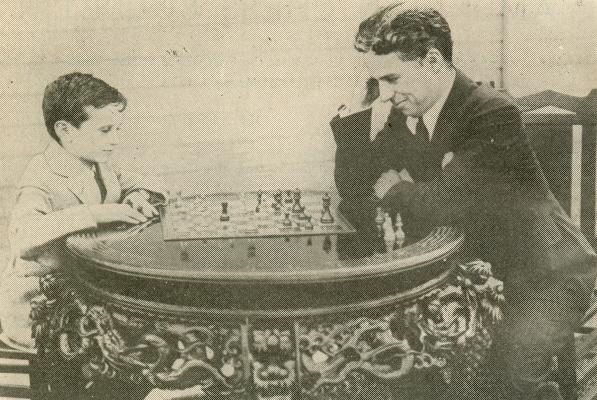
... and we noted that a signed copy (‘To my friend Sammy With very best wishes From Charlie Chaplin’) was published on page 320 of the October 1963 Chess Review.
Olimpiu G. Urcan (Singapore) has found this report on page 18 of the New York Evening Telegram, 28 December 1921:

(7531)
In an article on the inside front cover of Chess Review, October 1951 Irving Chernev made a statement on which we would welcome particulars:
‘Reshevsky made his debut on the radio by singing a love song.’
(3807)
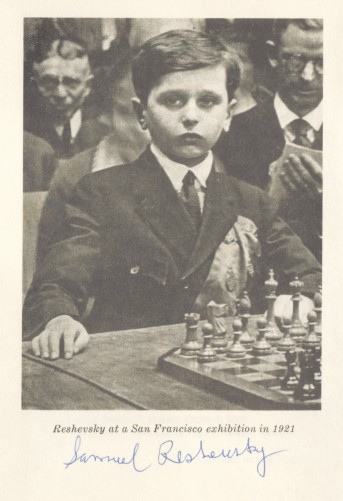
The photograph below was taken before a 20-board simultaneous display by Reshevsky in Cleveland on 27 January 1921:
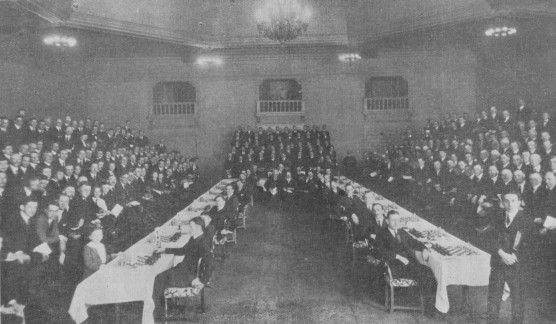
(3812)
Below are two games by the prodigy which are not in Stephen W. Gordon’s ‘complete games’ collection Samuel Reshevsky (Jefferson, 1997):
Samuel Herman Reshevsky – C. Degraeve1 e4 e5 2 f4 Bc5 3 Nf3 d6 4 Bc4 Nc6 5 c3 Nf6 6 d4 exd4 7 cxd4 Bb4+ 8 Bd2 Bxd2+ 9 Nbxd2 O-O 10 d5 Ne7 11 O-O c6 12 dxc6 bxc6 13 Qc2 d5 14 exd5 Bf5 15 Qc3 Nexd5 16 Qd4 Qb6 17 Qxb6 axb6 18 Nd4 Bd7 19 Bb3 Rfe8 20 g3 c5 21 N4f3 Bc6 22 Ne5 Bb7 23 Ndc4 Re7 24 Rfe1 b5 25 Nd6 c4 26 Bd1 Ba6 27 Bf3 Rd8 28 Nf5 Ree8 29 Rad1 Bb7 30 a4 bxa4 31 Nxc4 Rxe1+ 32 Rxe1 Bc8 33 Nfd6 Ba6 34 Rc1 Bxc4 35 Nxc4 Rc8 36 Rc2 Nb6 37 Na3 Rxc2 38 Nxc2 Nc4 39 Kf2 Nxb2 40 Ke2 Nc4 41 Kd3 Nb6 42 Kd4 Kf8 43 Kc5 Nfd7+ 44 Kb4 Ke7 45 Nd4 g6 46 Bc6 f5 47 Bxa4 Nxa4 48 Kxa4 Kd6 49 Kb5 Nf6 50 Nf3 Ne4 51 Kc4 Kc6 52 Kd4 Kd6 53 g4 Ke6 54 h3 Kd6 55 Nh4 Ke6 56 Ng2 Kd6 57 Ne3 Ke6 Drawn.
Source: La Stratégie, June 1920, pages 122-123.
Samuel Herman Reshevsky – M. Billoret1 e4 e6 2 d4 d5 3 e5 c5 4 c3 Nc6 5 Nf3 Nge7 6 Bd3 Ng6 7 O-O cxd4 8 cxd4 Be7 9 a3 O-O 10 g3 Qe8 11 h4 f6 12 Re1 f5 13 Kg2 f4 14 h5 Nh8 15 Bxf4 Rxf4 16 gxf4 Qxh5 17 Rh1 Qg4+ 18 Kf1 Ng6 19 Nc3 Bd7 20 Bxg6 Qxg6 21 Ne2 Qg4 22 Qd3 h6 23 Rg1 Qh3+ 24 Ke1 Rf8 25 Kd2 Bg5 26 Nxg5 Qxd3+ 27 Kxd3 hxg5 28 Rxg5 Ne7 29 Rag1 Nf5 30 Ng3 Nxg3 31 fxg3 Bb5+ 32 Kd2 Rc8 33 Rc1 Rf8 34 Rc7 Rf7 35 Rxf7 Kxf7 36 f5 Bd7 37 fxe6+ Bxe6 38 Rh5 Kg8 39 Rh1 Bd7 40 Rc1 Bc6 41 b4 Kf7 42 b5 Resigns.
Source: La Stratégie, June 1920, page 126.
A third game from the French magazine, against L. Schwarz, was given in C.N. 2472 (and page 98 of A Chess Omnibus). However, that earlier item was incorrect to say that a fourth game in La Stratégie (a 70-move win against A. Silbert) was absent from Stephen W. Gordon’s book. We also add here that page 121 of the June 1920 issue of La Stratégie reported that on 20 June Reshevsky had played 14 lightning games (lasting an average of two minutes each) against E. Antoniadi, winning with a score of +12 –1 =1.
Still on the subject of Reshevsky, the photograph below, taken at the Hotel Breslin, New York on 27 February 1922, was published on page 44 of the March 1922 American Chess Bulletin:
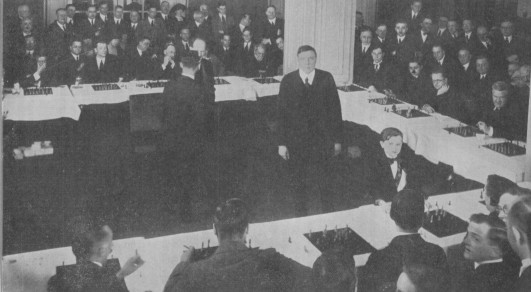
The caption states, ‘William F. Drueke of Grand Rapids is shown in the center and the sturdy back of Referee Katz is very much in evidence’. Having referred to two chess books by Drueke in C.N. 3738, we should welcome biographical information about him.
(3840)
This photograph, taken at Kalamazoo, 1927 (the first meeting of the National Chess Federation of the USA), was published on page 152 of the September-October 1927 American Chess Bulletin:
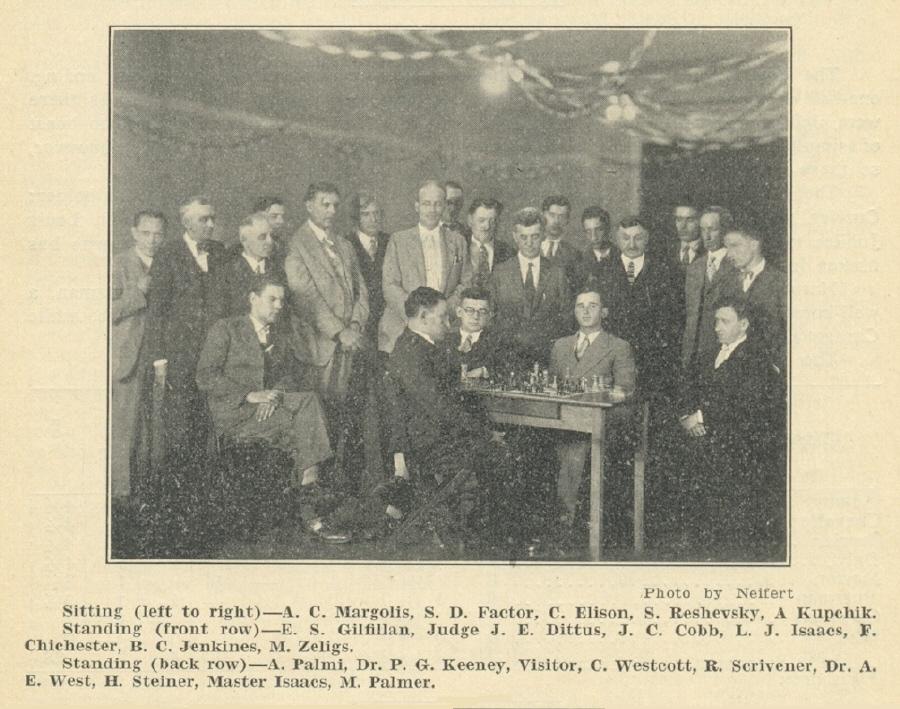
(4782)
We are grateful to Michael Clapham (Ipswich, England) for permission to reproduce from his collection this photograph of Samuel Reshevsky:
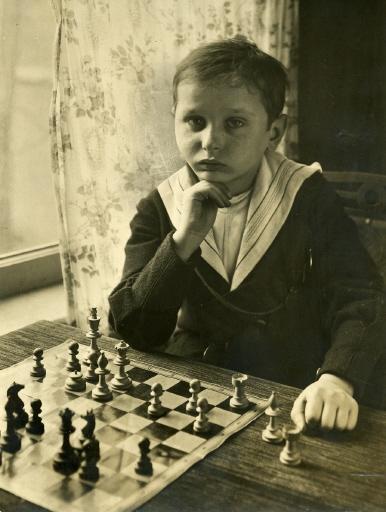
Samuel Reshevsky in the Netherlands, February or March 1920
(4791)
C.N. 2535 (see page 358 of A Chess Omnibus) cited the following from page 176 of the November 1920 American Chess Bulletin:
‘According to H.A. Horwood of Los Angeles, Cal., in the October “Folder” of the Good Companion Chess Problem Club, Carlos Torre, R., the boy expert of New Orleans, like Rzeschewski, has appeared in the “movies”.’
No further information has yet been found, and for now we can but add the exact text in the earlier publication:
‘H.A. Horwood, Los Angeles, Calif. “These are wonderful days for chess, as I saw last evening, in a moving picture theatre, an exhibition of our boy wonder, C. Reperto [sic], of New Orleans.”’
Source: “Our Folder”, 1 October 1920, page 11.
(4862)
1 d4 d5 2 Nf3 Nf6 3 e3 e6 4 c4 c5 5 Nc3 Nc6 6 a3 cxd4 7 exd4 Be7 8 Bd3 dxc4 9 Bxc4 a6 10 O-O Qc7 11 Re1 O-O 12 d5 Rd8 13 Bg5 Nb4 14 Qb3 Nbxd5
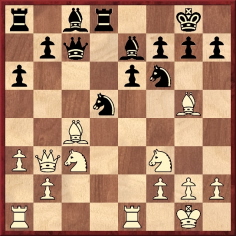
15 Bxd5 Nxd5 16 Nxd5 Rxd5 17 Bxe7 Qxe7 18 Qxd5 Resigns.
On page 6 of Samuel Reshevsky by Stephen W. Gordon (Jefferson, 1997) this game (‘Reshevsky – N.N.’) was described as played in a simultaneous display in Paris on 17 May 1920. No source was given, but we note that on pages 141-142 of Ajedrología by Julio Ganzo (Madrid, 1971) Black was named as ‘Mauvaisse’.
(4949)
Marek Soszynski (Birmingham, England) points out that the same game-score also appeared on the previous page of the Gordon book, where it was labelled as between Reshevsky and Guhre in a simultaneous display in Berlin on 14 January 1920.
(4956)
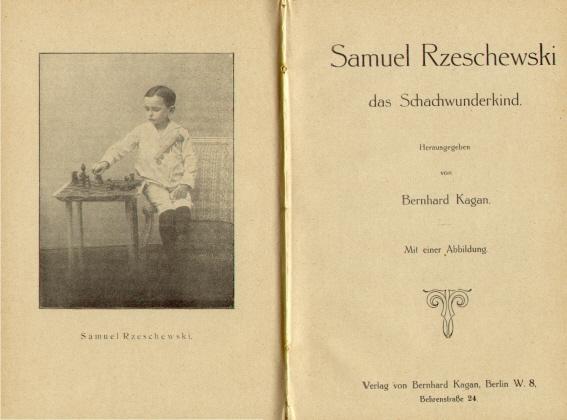
Harrie Grondijs (Rijswijk, the Netherlands) draws attention to an illustration opposite page 288 of the May 1935 issue of El Ajedrez Español:

(5202)
C.N. 996 (see page 120 of Chess Explorations) referred to a secret game between Reshevsky and Muffang played at Easter 1920, and we quoted CHESS, April 1945, page 113:
‘Reshevsky’s manager stipulated that the result of the game should not be made public unless Reshevsky won!! This 25-year-old undertaking has only now been broken.’
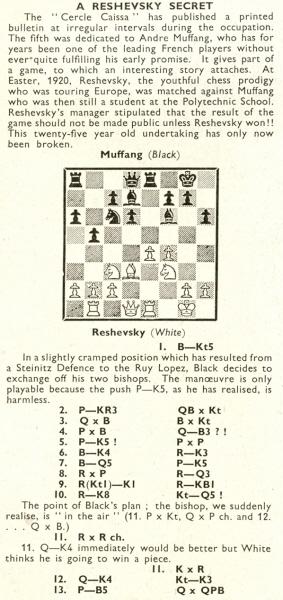
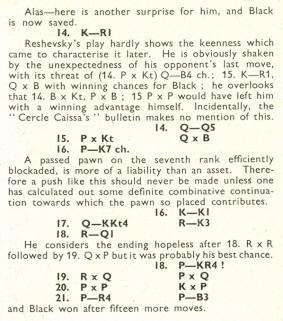
Dominique Thimognier (St Cyr sur Loire, France) provides the original text in issue 5 of Caïssa (1944):
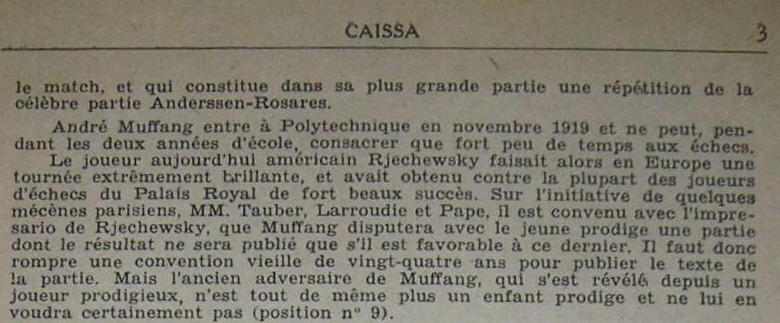
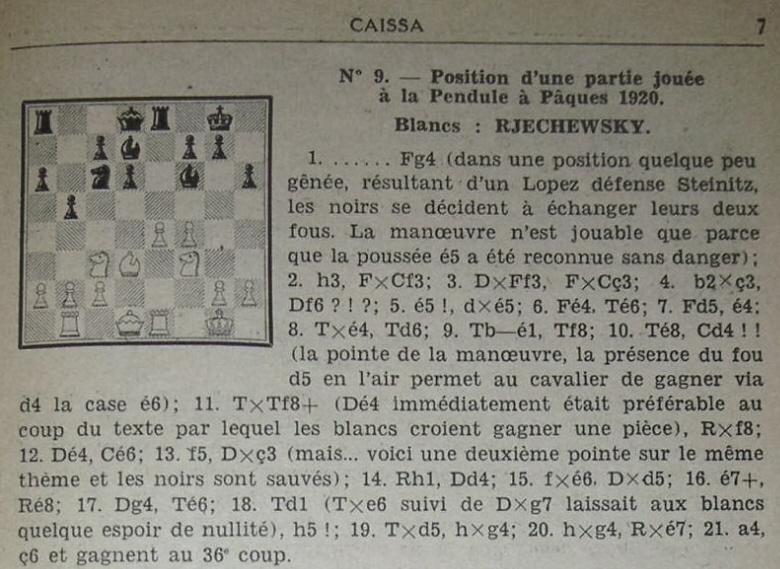
(5233)
In the ‘secret game’ between Reshevsky and Muffang the moves are available only as from this position:
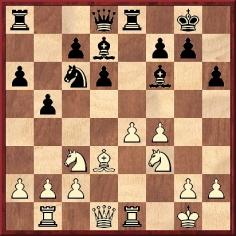
We have received from correspondents two reconstructions of the opening phase (other possibilities exist, of course):
(5255)
Below is another small example, from the article ‘Some Chess Memories’ by Constantine Rasis on pages 105-106 of Chess Life, April 1963 (C.N. 10188). The Western Chess Association tournament was held in Detroit from 23 August to 2 September 1924.
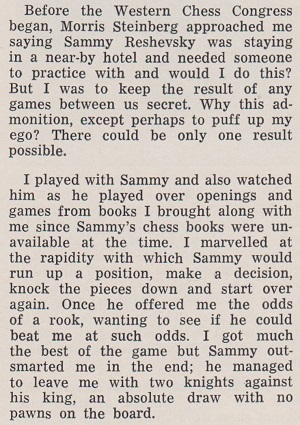
(10298)
Leibel Dearson (Jerusalem) draws attention to the following remark by George Bernard Shaw:
‘As I write these lines the newspapers are occupied by the exploits of a child of eight, who has just defeated 20 adult chessplayers in 20 games played simultaneously, and has been able afterwards to reconstruct all the 20 games without any apparent effort of memory. Most people, including myself, play chess (when they play it at all) from hand to mouth, and can hardly recall the last move but one, or foresee the next but two.’
Source: Back to Methuselah. A Metabiological Pentateuch by G. Bernard Shaw (London, 1921), page xxv.
The prodigy in question was evidently Reshevsky.
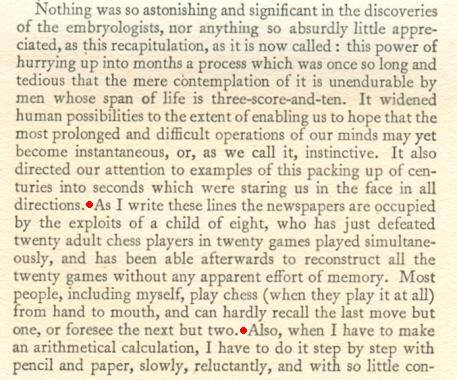
The best-known remark about chess by Shaw appeared in The Irrational Knot:
‘Playing with Ned! No: he hates chess. He says it is a foolish expedient for making idle people believe they are doing something very clever when they are only wasting their time. He actually grumbled about the price of the table and the pieces; but I insisted on having them, I suppose in remembrance of you.’
This was quoted, in part, on page 30 of Chess Pieces by Norman Knight (London, 1949), after which Knight reported that he had asked Shaw whether he still held that opinion. In a postcard dated 22 August 1946 Shaw replied:
‘I have no recollection of the passage. I am hopeless as a chessplayer; I never can see more than two moves ahead. I was taught the names of the pieces and the moves by my Mother when I was a child; but my genius did not point in that direction.’
Page 21 of King, Queen and Knight by Norman Knight and Will Guy (London, 1975) quoted from Shaw’s The Admirable Bashville:
‘The world’s a chess-board,
And we the merest pawns in fist of fate.’
(5627)
The article by Irving Chernev on the inside front cover of the
April 1954 Chess Review (C.N. 6077) included 15 alleged
quotes, none with sources. One was: ‘That boy understands as much
of chess as I do of rope dancing.’ Page 125 mentioned that the
speaker was ‘Janowsky, referring to his game with the prodigy
Reshevsky’. The complete feature was reproduced on page 271 of
Chernev’s The Chess Companion (New York, 1968).
On page 243 of Chess Secrets I Learned from the Masters by Edward Lasker (New York, 1951) it was reported that Janowsky had made the remark to Lasker after 12 moves of the game Janowsky v Reshevsky, New York, 1922. It was a famous victory for the ten-year-old prodigy, and the following appeared on page 18 of Reshevsky on Chess (New York, 1948):
‘I was so excited and happy that I rushed home in a taxi to tell my father and mother. I couldn’t even sit down in the taxi. I jumped up and down all the way. When I got to the hotel, I ran up the stairs to our rooms, without waiting for the elevator, and broke the news to my parents: I had won from Janowsky! And then I sang. I sang so loudly that nobody could talk. It was one of the happiest days of my life.’
In Edward Lasker’s version (pages 247-248 of Chess Secrets) the prodigy’s father was in the taxi. The report on page 28 of the Sports Section of the New York Times, 13 October 1922 stated:
‘After 65 moves had been recorded, Janowsky, seeing his pawns falling one by one, resigned and was the first to offer his congratulations to the boy.’
This photograph was given on page 158 of the November 1922 American Chess Bulletin:
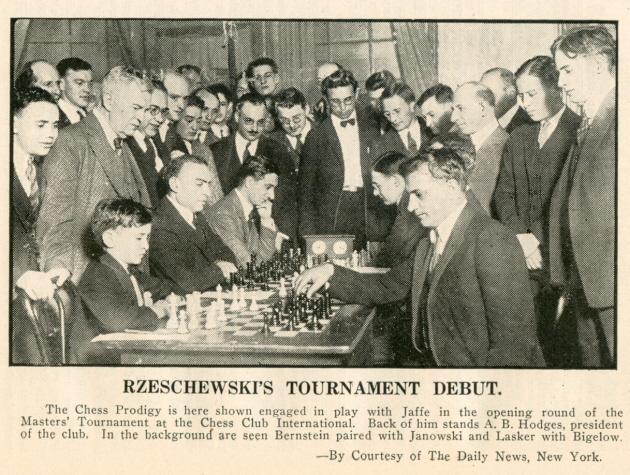
The tournament received a brief mention on pages 193-194 of A History of Chess by H. Golombek (London, 1976). Reshevsky’s final score and his placing were incorrect, as were Bigelow’s. Jacob Bernstein was misidentified as ‘S. Bernstein’, and the index reference to Jaffe gave his forename as Oscar, instead of Charles.
(6083)
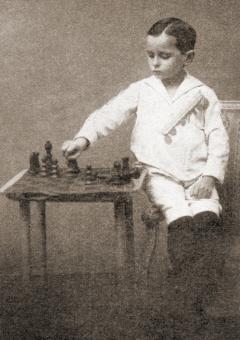
Samuel Reshevsky
Dominique Thimognier (Fondettes, France) draws our attention to his webpage on Reshevsky in Paris in 1920. In addition to reports and photographs, there are two game-scores absent from Samuel Reshevsky by Stephen W. Gordon (Jefferson, 1997), the opponents being Marc Herzfeld and Max de Gency.
(6564)
This particularly early photograph of Reshevsky, from page 11 of Wiener Bilder, 30 September 1917, has been submitted by Jan Kalendovský (Brno, Czech Republic):
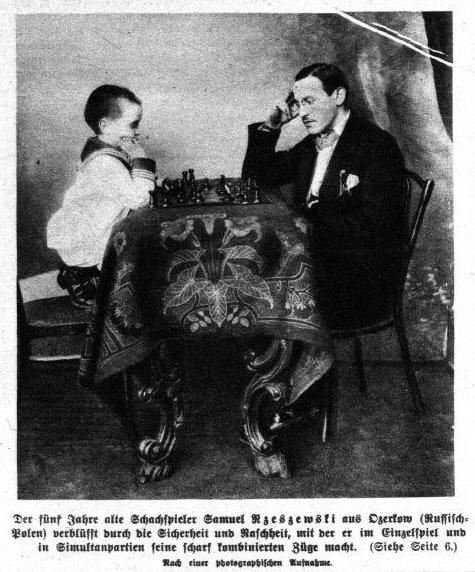
(6701)
From page 6 of Das interessante Blatt, 13 September 1917:
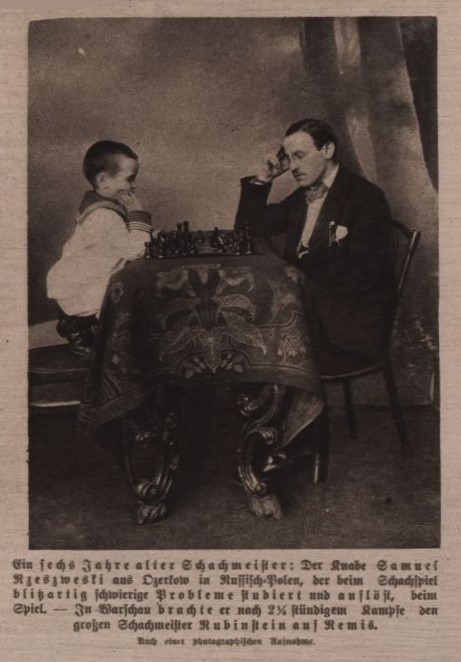
This is a better version of the picture given in C.N. 6701.
(9572)
Robert Sherwood (E. Dummerston, VT, USA) points out this photograph on page 23 of the February 1921 American Chess Bulletin:
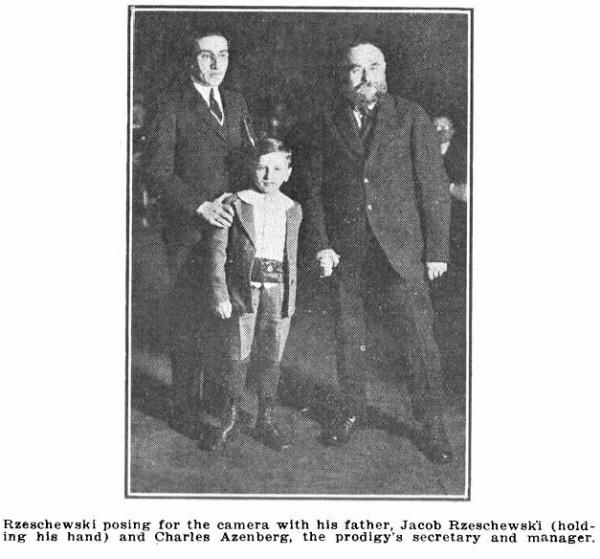
(6717)
Olimpiu G. Urcan mentions that a better copy of the Reshevsky photograph can be viewed in the Cleveland Public Library Digital Gallery.
(6721)
At a simultaneous display in Portland on 10 June 1921 the prodigy Samuel Reshevsky (then aged nine) had an opponent who was little more than half his age. Page 143 of the July-August 1921 issue of the American Chess Bulletin reported that one of Reshevsky’s wins was against ‘Master Edward Myer (five years old)’.
(6871)
Russell Miller (Vancouver, WA, USA) sends a number of reports from The Oregonian about Reshevsky’s visit to Portland. This illustration was on page 4 of the 3 June 1921 issue:
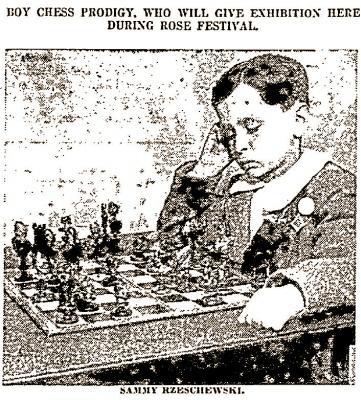
C.N. 6871 noted the American Chess Bulletin’s statement that one of Reshevsky’s opponents in a simultaneous display on 10 June 1921 was five-year-old Edward Myer. However, page 15 of the 8 June 1921 issue of The Oregonian related:
‘One match will be between the visitor and Robert Myers, son of the ex-postmaster, Frank S. Myers, who is the same age as the boy marvel, and says he is going to give his opponent the tussle of his life on this occasion.’
‘Robert Myers’ was also the name in the newspaper’s report on the display (11 June 1921 edition, page 6). The account was reproduced on page 83 of the 8/2002 Quarterly for Chess History, a publication whose coverage of the prodigy’s tours sprawled across three consecutive issues, with a total of nearly 260 pages.
(6878)
John Blackstone (Las Vegas, NV, USA) draws attention to an article ‘An Adult Views All These Child Prodigies With Alarm’ by Edwin H. Blanchard in the New York Evening Post, 3 December 1920. Below is the paragraph regarding chess:
‘This invasion of the innocents is not confined to literature. Take Samuel Rzesce – that is, Samuel Rcezcs – well, you know whom I mean – the Polish boy wizard, eight years old or so, who comes over here and beats the pick of West Point playing chess. What’s to be made from that? What’s the sense of spending a lot of money training army officers for four years if a child eight years old can come over from Poland and beat them all at once? What’s to prevent Samuel, the boy wonder, from going back to Poland and getting four or five of his little chums and coming back here and capturing the entire coast defences? The thing is internationally serious.’
(7004)
John Blackstone sends this article from page A11 of the Brooklyn Daily Eagle, 15 October 1922:
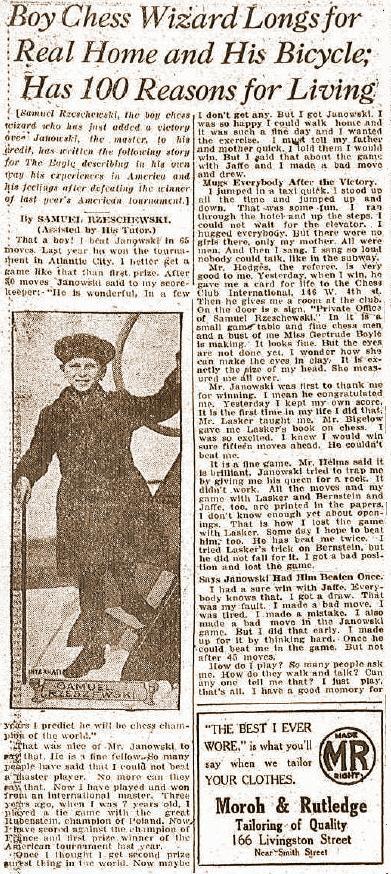
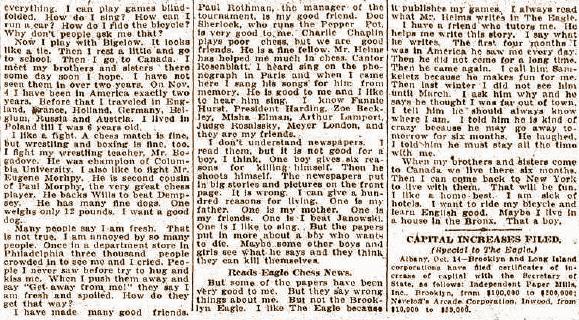
Among the points of interest are the boy’s comments on Janowsky, whom he had defeated in the New York tournament (see C.N. 6083). There is also an apparent reference to having drawn a game against Rubinstein in 1919. We note too the remarks about Charlie Chaplin.
(7236)
Olimpiu G. Urcan also points out the Süddeutsche Zeitung Photo website. A search for ‘Schach’ yields many photographs of chess masters past and present. We note, for instance, a 1921 shot of Samuel Reshevsky boxing against the Hollywood prodigy Jackie Coogan.
(7784)
Olimpiu G. Urcan notes a Dutch website which purports to show a photograph of Capablanca giving a simultaneous exhibition in Havana in 1897.
As pointed out by us on page 52 of the Winter 2000 issue of Kingpin, the front page of the Cuban newspaper Juventud Rebelde dated 13 November 1988 also claimed that the picture showed Capablanca ...
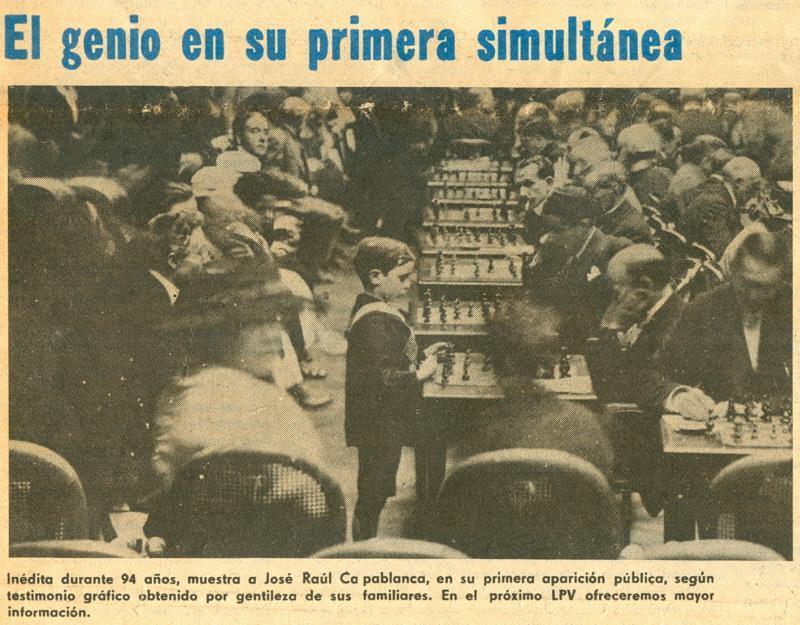
... whereas in reality the prodigy was Reshevsky. He was dressed similarly in a photograph given in C.N. 4212 courtesy of Richard Benjamin (Marietta, GA, USA):
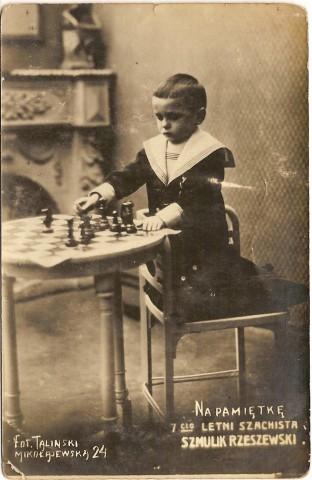
(8034)
See also Copying.
From Dominique Thimognier comes the front cover of Le Miroir, 23 May 1920:
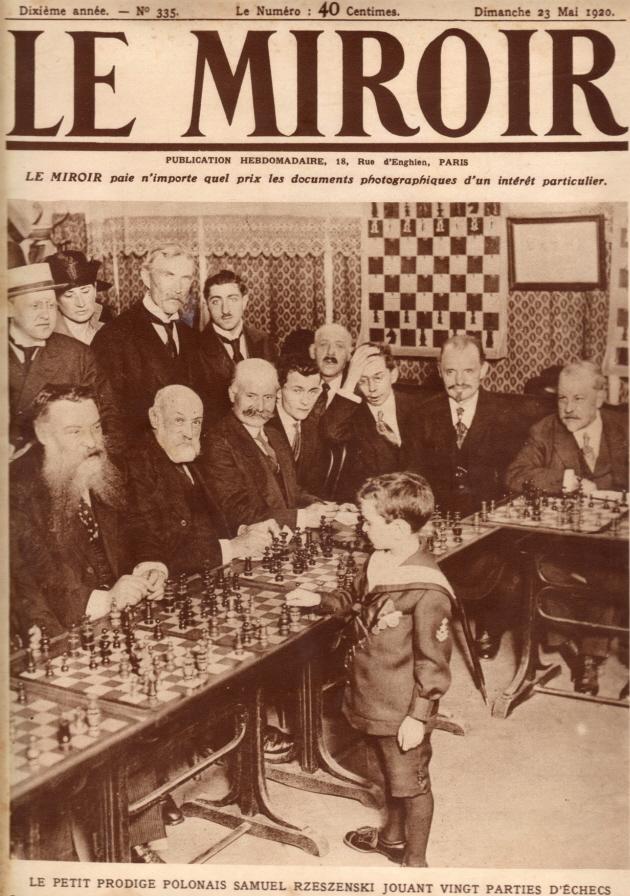
(8042)
Olimpiu G. Urcan shows the coverage of this exhibition on page 4 of the 17 May 1920 edition of Excelsior:
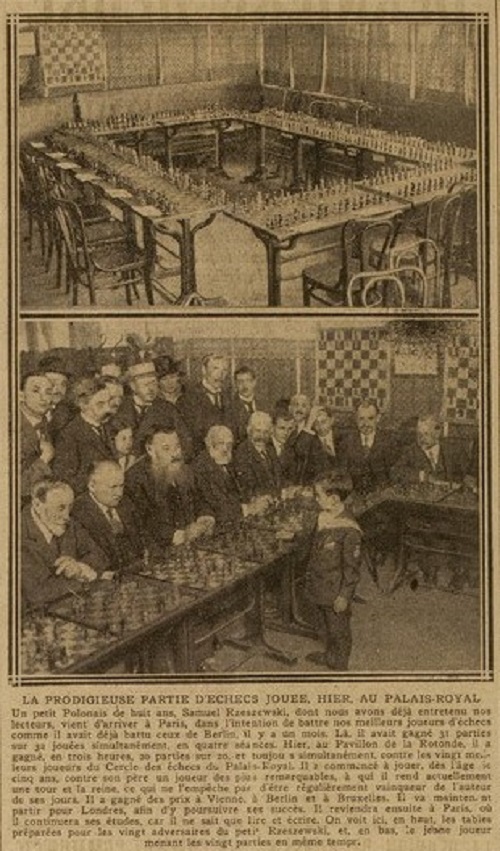
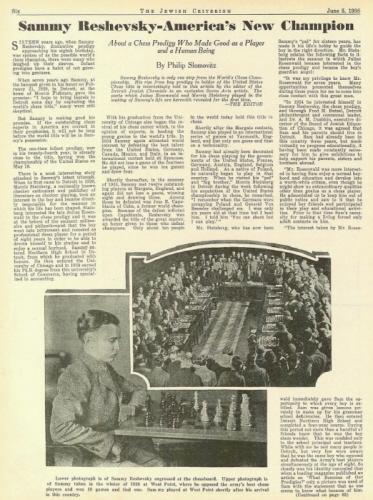
Harrie Grondijs (Rijswijk, the Netherlands) has forwarded an article about Reshevsky by Philip Slomovitz in the Jewish Criterion, 5 June 1936, page 6 and page 32.
(8374)
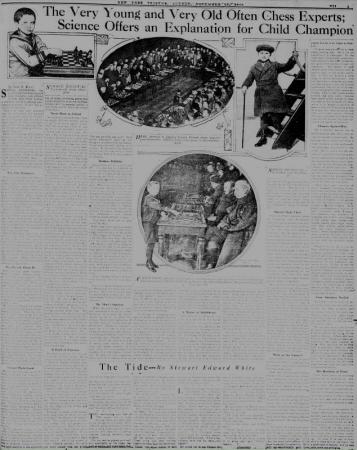
John Blackstone has submitted a full-page article about Samuel Reshevsky in the New York Tribune, 21 November 1920 (page 5). Can a clearer copy be found?
(8442)
From page 6 of the Brainerd Daily Dispatch, 18 October 1922:
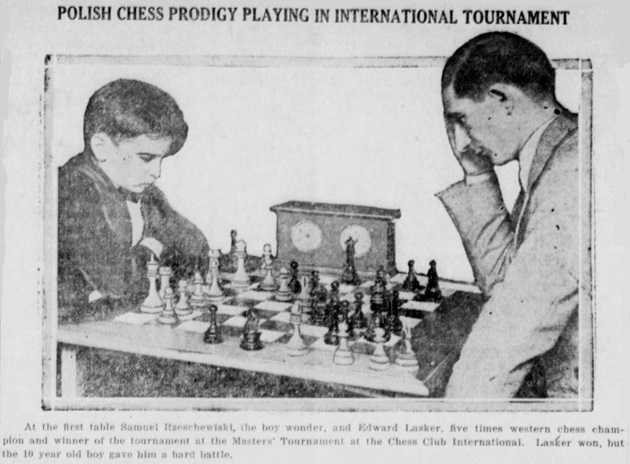
The game was annotated by Lasker on pages 237-242 of Chess Secrets I Learned from the Masters (New York, 1951).
(9204)
The Gallica website has a photograph of the prodigy Reshevsky with the opera singer Joseph Schwarz (1880-1926).
(9277)
From page 7 of the Sunday Sun (Newcastle), 12 February 1922:
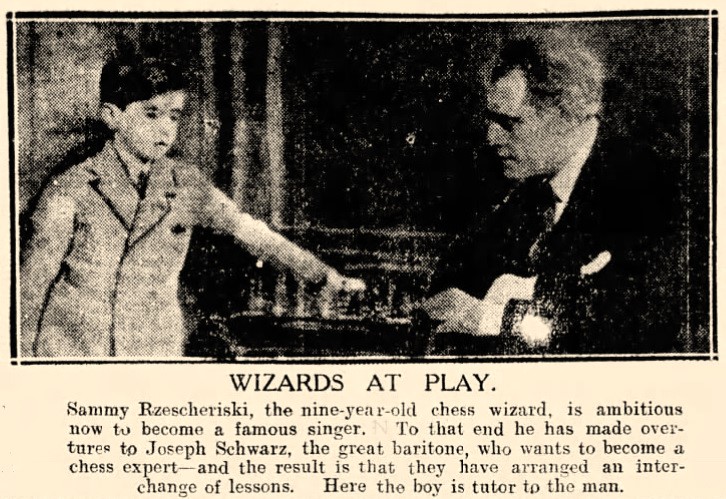
The picture is a crude version of a photograph on Gallica mentioned in C.N. 9277.
Many newspapers reported in 1922 that Reshevsky and Joseph Schwarz intended to give each other lessons. The level of reportage is exemplified by page 3 of the Buffalo Evening Times, 6 January 1922:
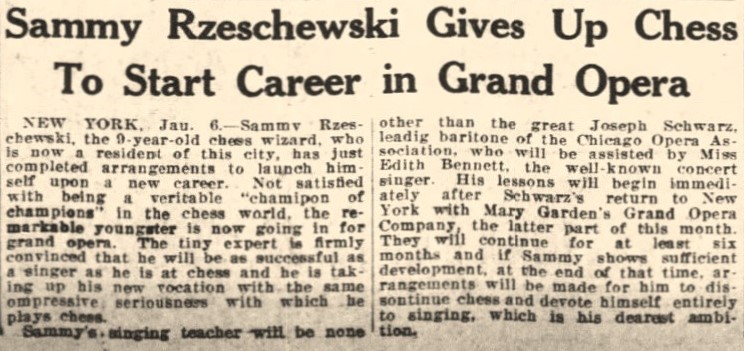
(9277)
From page 61 (page 2 of the Sporting Section) of the Brooklyn Daily Eagle, 12 December 1920:
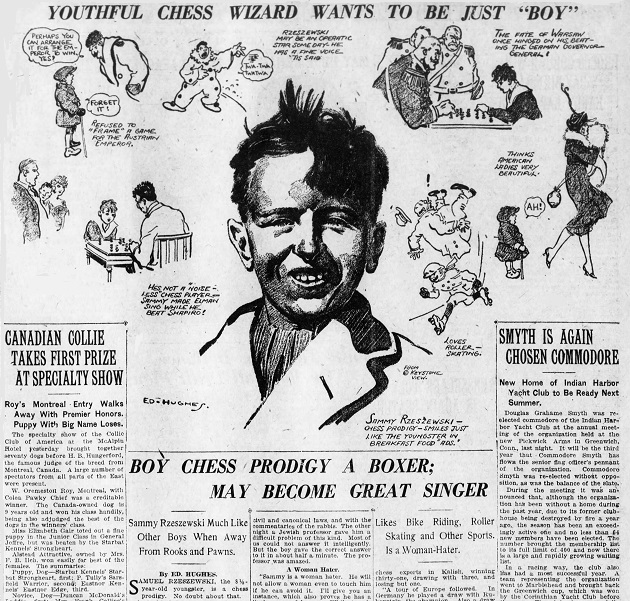
Larger version (with the full article)
(9187)
Gerard Killoran (Ilkley, England) draws attention to the photographs of Capablanca giving simultaneous exhibitions in the Illustrated World (1919), page 934, and the New York Times Pictorial Portfolio of the World (1922), page 410. The latter publication also has a fine portrait of Reshevsky.
(9479)
A news item on page 8 of section two of the Pittsburgh Sunday Post, 19 November 1922:
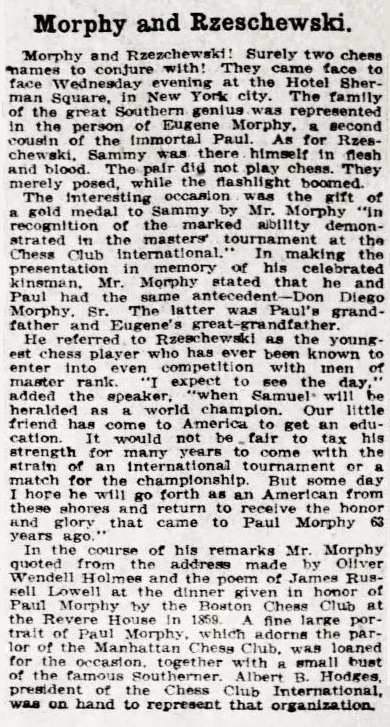
(10490)
From page 8 of the Boston Globe, 22 November 1920:
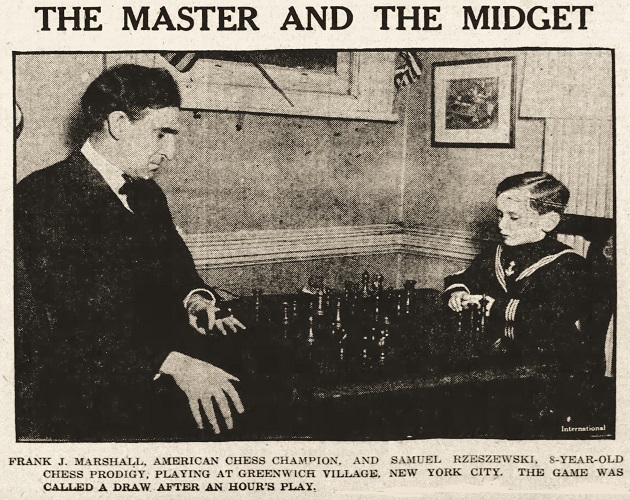
(10948)
As mentioned on page 259 of Chess Explorations and in C.N. 1943 (see pages 202-203 of Kings, Commoners and Knaves), a claim emerged in the early 1990s that Samuel Reshevsky was born in 1909 and not, as commonly accepted, in 1911.
The matter is discussed by Bruce Monson in an article about Reshevsky on pages 46-55 of the 1/2019 New in Chess.
(11199)
For further details, see our article Testing Reshevsky, and in particular C.N. 12035.
From page 14 of the Boston Post, 11 November 1920:
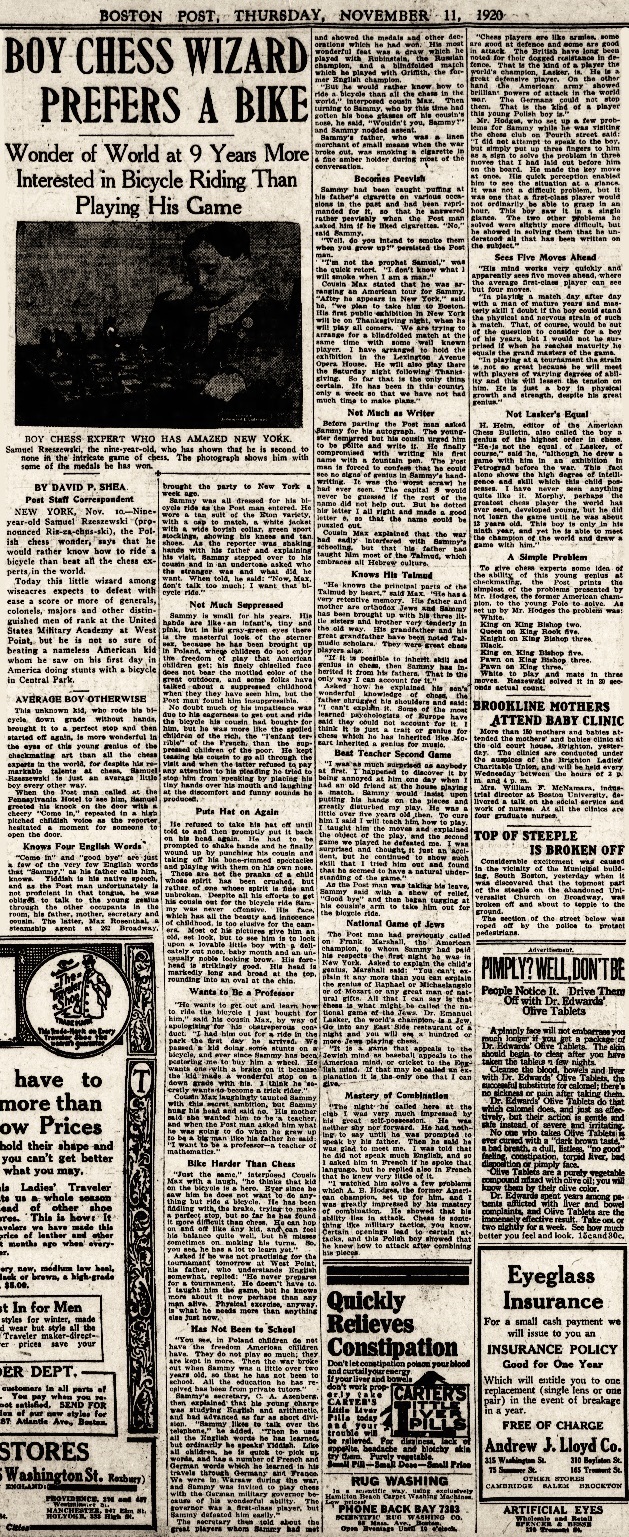
The three-mover by A.B. Hodges which Reshevsky solved in 30 seconds (given at the end of the article):
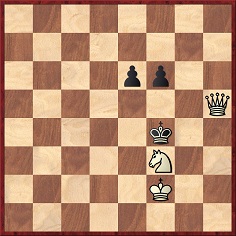
See too pages 317-318 and 510-511 of Albert Beauregard Hodges by John S. Hilbert and Peter P. Lahde (Jefferson, 2008).
(11200)
Page 10 of Kings, Commoners and Knaves gave a mate-in-three problem composed by Reshevsky before he was nine years old. It was one of two on page 182 of the American Chess Bulletin, November 1920, and we originally showed it in Kingpin in 1992.
From our feature article on chess photographs in the Daily Mirror:
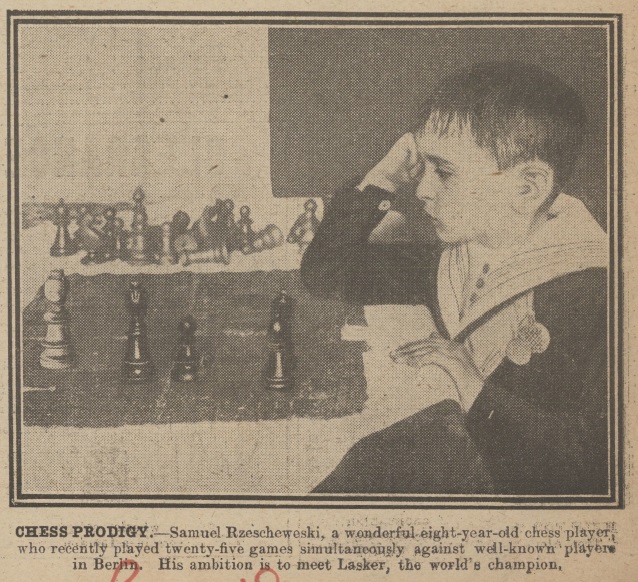
2 February 1920, page 9
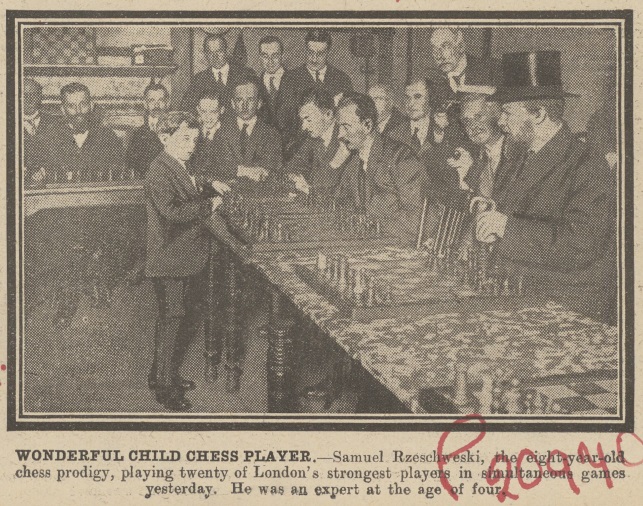
11 August 1920, page 6
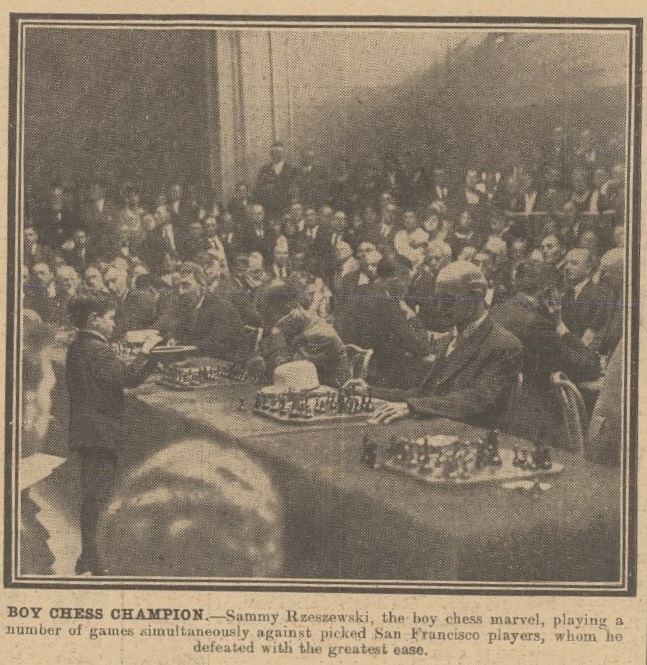
8 December 1921, page 8
Olimpiu G. Urcan has sent us two photographs from Bettmann Archive which are reproduced here with permission:
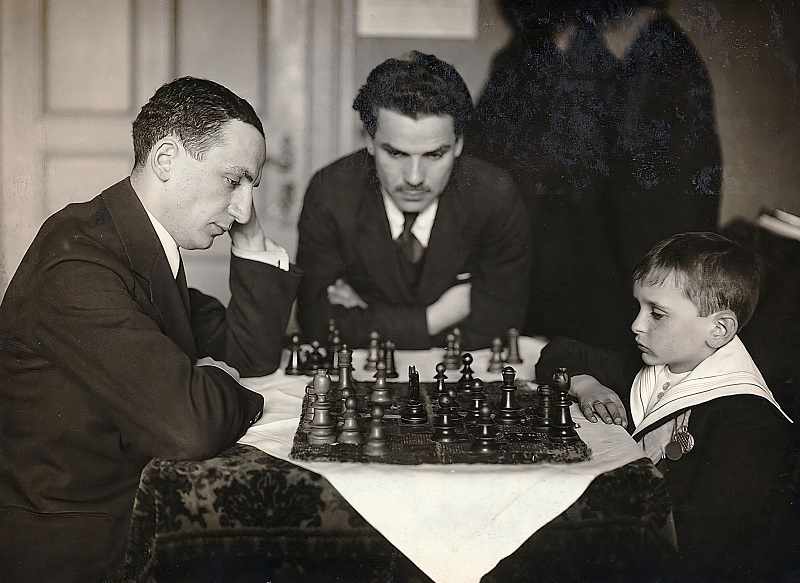
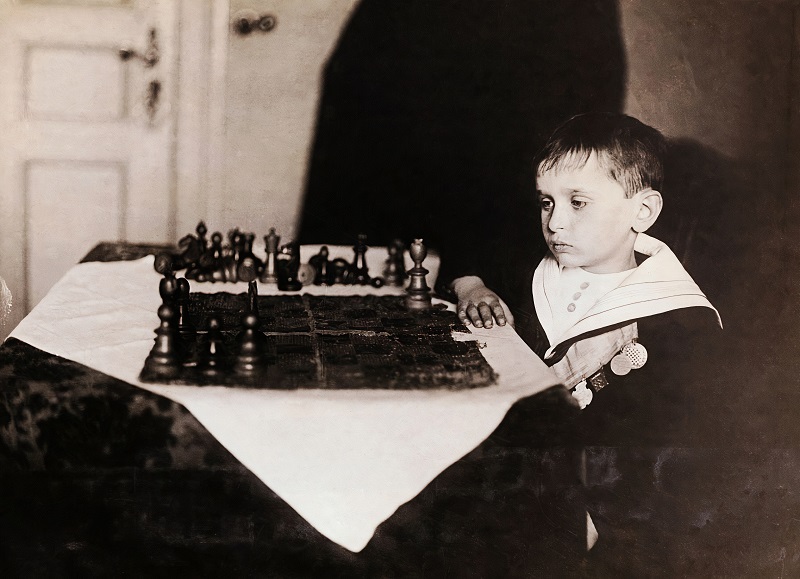
Further material on the prodigy Reshevsky is given on Mr Urcan’s Patreon webpage. It includes footage of a simultaneous exhibition by Reshevsky in Paris in May 1920.
From Michael Clapham:
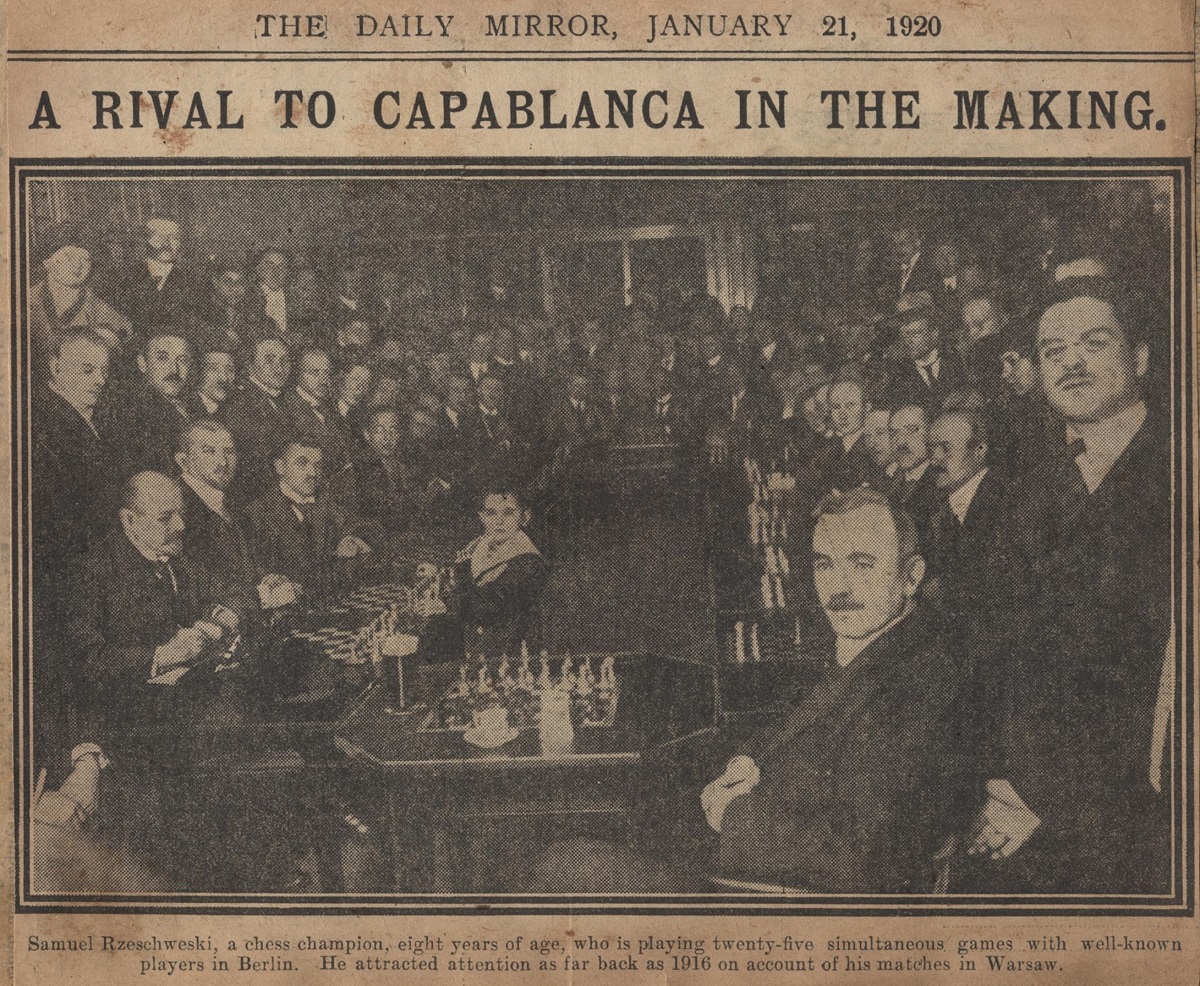
The photograph is on pages 8 and 9.
Olimpiu G. Urcan sends the photograph referred to in C.N. 7784:
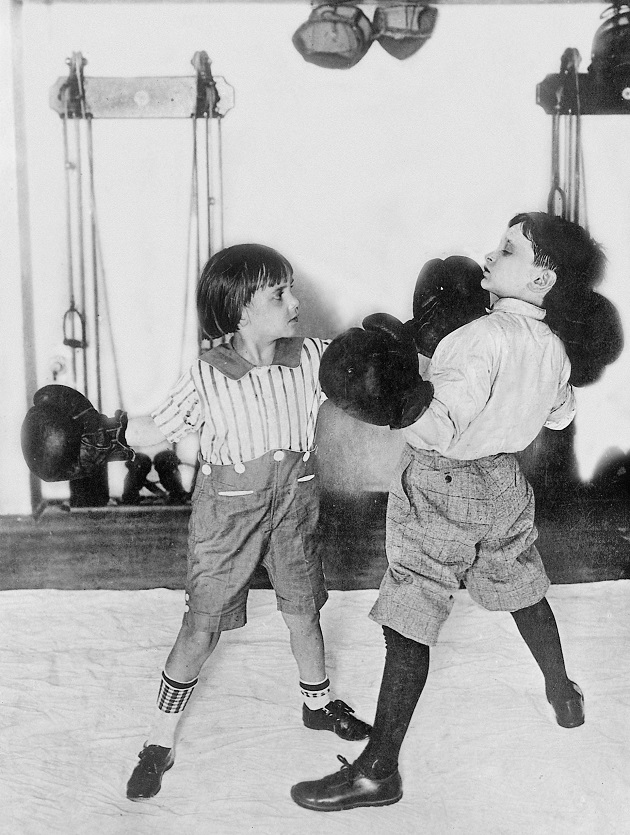
He also provides this cutting from page 8 of the Los Angeles Record, 18 July 1921:
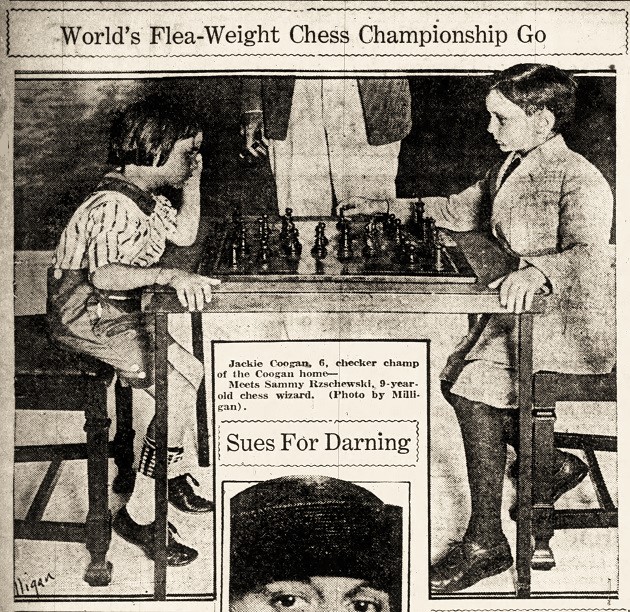
Earlier that year, Jackie Coogan became famous for playing the title role in the Charlie Chaplin film The Kid.
Avital Pilpel (Haifa, Israel) sends, courtesy of Herbert Halsegger, a feature about the prodigy Reshevsky on page 2 of part 6 of the Richmond Times-Dispatch, 20 March 1921:
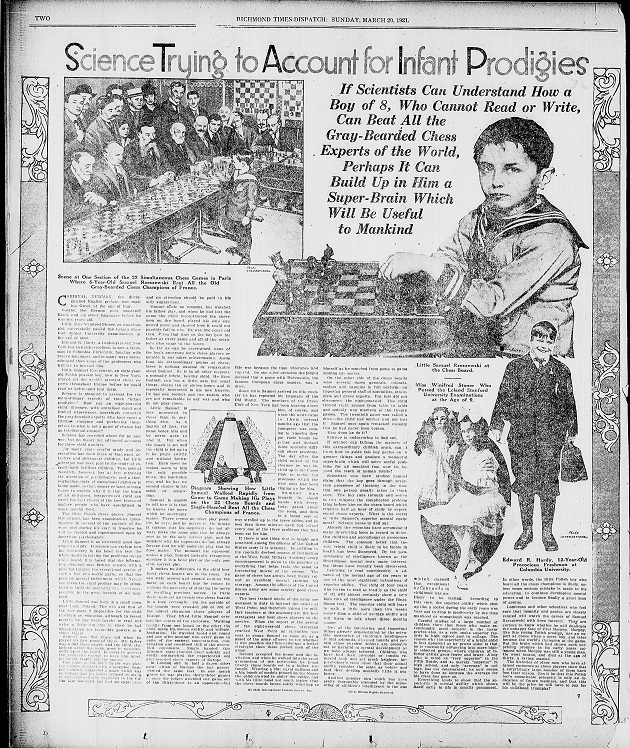
(11987)
Christian Sánchez (Rosario, Argentina) points out an article by Henry Smith Williams about Reshevsky on page 43 of the October 1920 issue of Hearst’s.
(12009)
See too Testing Reshevsky and our more general feature article Chess Prodigies.
To the Chess Notes main page.
To the Archives for other feature articles.
Copyright: Edward Winter. All rights reserved.